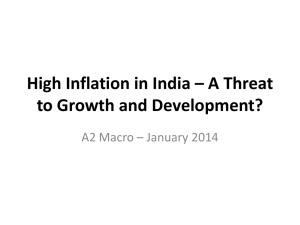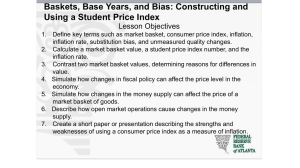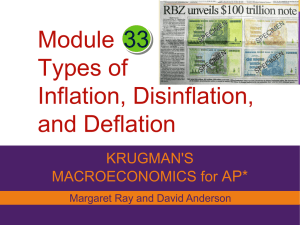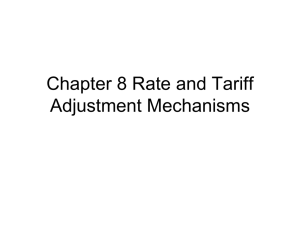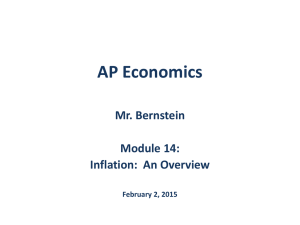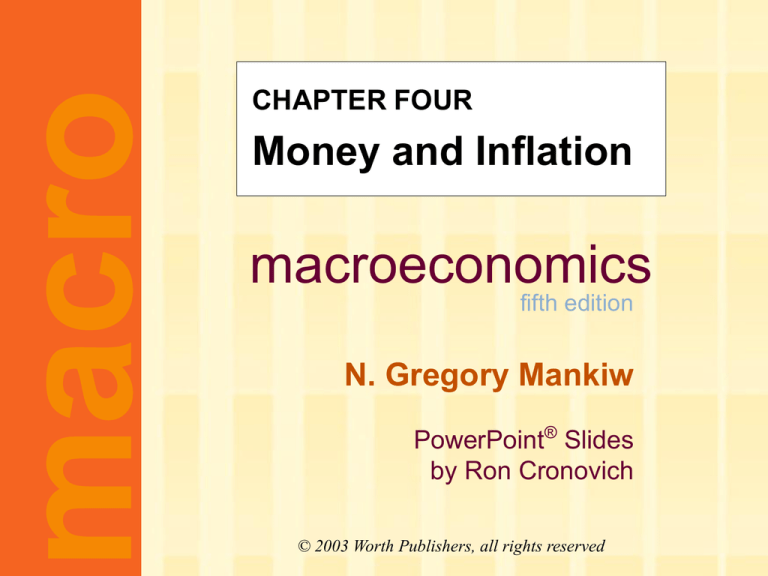
macro
CHAPTER FOUR
Money and Inflation
macroeconomics
fifth edition
N. Gregory Mankiw
PowerPoint® Slides
by Ron Cronovich
© 2003 Worth Publishers, all rights reserved
In this chapter you will learn
The classical theory of inflation
– causes
– effects
– social costs
“Classical” -- assumes prices are flexible &
markets clear.
Applies to the long run.
CHAPTER 4
Money and Inflation
slide 1
U.S. inflation & its trend, 1960-2003
14%
12%
10%
8%
6%
4%
2%
0%
1960
1965
1970
1975
1980
1985
1990
1995
2000
Inflation rate
CHAPTER 4
Money and Inflation
slide 2
U.S. inflation & its trend, 1960-2003
14%
12%
10%
8%
6%
4%
2%
0%
1960
1965
1970
1975
Inflation rate
CHAPTER 4
1980
1985
1990
1995
2000
Inflation rate trend
Money and Inflation
slide 3
The connection between
money and prices
Inflation rate = the percentage increase
in the average level of prices.
price = amount of money required to
buy a good.
Because prices are defined in terms of money,
we need to consider the nature of money,
the supply of money, and how it is controlled.
CHAPTER 4
Money and Inflation
slide 4
Money: definition
Money is the stock
of assets that can be
readily used to make
transactions.
CHAPTER 4
Money and Inflation
slide 5
Money: functions
1. medium of exchange
we use it to buy stuff
2. store of value
transfers purchasing power from the
present to the future
3. unit of account
the common unit by which everyone
measures prices and values
CHAPTER 4
Money and Inflation
slide 6
Money: types
1. fiat money
• has no intrinsic value
•
example: the paper currency we use
2. commodity money
• has intrinsic value
•
examples: gold coins,
cigarettes in P.O.W. camps
CHAPTER 4
Money and Inflation
slide 7
Discussion Question
Which of these are money?
a. Currency
b. Checks
c. Deposits in checking accounts
(called demand deposits)
d. Credit cards
e. Certificates of deposit
(called time deposits)
CHAPTER 4
Money and Inflation
slide 8
The money supply & monetary policy
The money supply is the quantity
of money available in the economy.
Monetary policy is the control over
the money supply.
CHAPTER 4
Money and Inflation
slide 9
The central bank
Monetary policy is conducted by a country’s
central bank.
In the U.S.,
the central
bank is called
the Federal
Reserve
(“the Fed”).
The Federal Reserve Building
Washington, DC
CHAPTER 4
Money and Inflation
slide 10
Money supply measures, April 2002
_Symbol
C
Assets included
Amount (billions)_
Currency
$598.7
M1
C + demand deposits,
travelers’ checks,
other checkable deposits
1174.0
M2
M1 + small time deposits,
5480.1
savings deposits,
money market mutual funds,
money market deposit accounts
M3
M2 + large time deposits,
repurchase agreements,
institutional money market
mutual fund balances
CHAPTER 4
Money and Inflation
8054.4
slide 11
The Quantity Theory of Money
A simple theory linking the inflation
rate to the growth rate of the
money supply.
Begins with a concept called
“velocity”…
CHAPTER 4
Money and Inflation
slide 12
Velocity
basic concept: the rate at which money
circulates
definition: the number of times the average
dollar bill changes hands in a given time period
example: In 2003,
• $500 billion in transactions
• money supply = $100 billion
• The average dollar is used in five
transactions in 2003
• So, velocity = 5
CHAPTER 4
Money and Inflation
slide 13
Velocity, cont.
This suggests the following definition:
T
V
M
where
V = velocity
T = value of all transactions
M = money supply
CHAPTER 4
Money and Inflation
slide 14
Velocity, cont.
Use nominal GDP as a proxy for total
transactions.
Then,
P Y
V
M
where
P = price of output
(GDP deflator)
Y = quantity of output (real GDP)
P Y = value of output
(nominal GDP)
CHAPTER 4
Money and Inflation
slide 15
The quantity equation
The quantity equation
M V = P Y
follows from the preceding definition of
velocity.
It is an identity:
it holds by definition of the variables.
CHAPTER 4
Money and Inflation
slide 16
Money demand and the quantity equation
M/P = real money balances, the
purchasing power of the money supply.
A simple money demand function:
(M/P )d = k Y
where
k = how much money people wish to hold
for each dollar of income.
(k is exogenous)
CHAPTER 4
Money and Inflation
slide 17
Money demand and the quantity equation
money demand:
(M/P )d = k Y
quantity equation: M V = P Y
The connection between them: k = 1/V
When people hold lots of money relative to
their incomes (k is high), money changes
hands infrequently (V is low).
CHAPTER 4
Money and Inflation
slide 18
back to the Quantity Theory of Money
starts with quantity equation
assumes V is constant & exogenous:
V V
With this assumption, the quantity
equation can be written as
M V P Y
CHAPTER 4
Money and Inflation
slide 19
The Quantity Theory of Money, cont.
M V P Y
How the price level is determined:
With V constant, the money supply
determines nominal GDP (P Y )
Real GDP is determined by the economy’s
supplies of K and L and the production
function (chap 3)
The price level is
P = (nominal GDP)/(real GDP)
CHAPTER 4
Money and Inflation
slide 20
The Quantity Theory of Money, cont.
Recall from Chapter 2:
The growth rate of a product equals
the sum of the growth rates.
The quantity equation in growth rates:
M
M
V
V
P
P
Y
Y
The quantity theory of money assumes
V
V is constant, so
= 0.
V
CHAPTER 4
Money and Inflation
slide 21
The Quantity Theory of Money, cont.
Let (Greek letter “pi”)
denote the inflation rate:
The result from the
preceding slide was:
Solve this result
for to get
CHAPTER 4
M
M
Money and Inflation
M
M
P
P
P
P
Y
Y
Y
Y
slide 22
The Quantity Theory of Money, cont.
M
M
Y
Y
Normal economic growth requires a
certain amount of money supply growth
to facilitate the growth in transactions.
Money growth in excess of this amount
leads to inflation.
CHAPTER 4
Money and Inflation
slide 23
The Quantity Theory of Money, cont.
M
M
Y
Y
Y/Y depends on growth in the factors of
production and on technological progress
(all of which we take as given, for now).
Hence, the Quantity Theory of Money predicts a
one-for-one relation between changes in the money
growth rate and changes in the inflation rate.
CHAPTER 4
Money and Inflation
slide 24
International data on
inflation and money growth
Inflation rate 10,000
(per ce nt,
loga rithmic
sc ale)
1,000
Democratic Re public
of Congo
Nicaragua
Angola
Brazil
Georgia
100
Bulgaria
10
Germany
Kuwait
1
USA
Oman
0.1
0.1
CHAPTER 4
1
J apan
10
Canada
100
1,000
10,000
Mone y supply gr owth (per ce nt, logar ithmic sc ale )
Money and Inflation
slide 25
U.S. Inflation & Money Growth, 1960-2003
14%
12%
10%
8%
6%
4%
2%
0%
1960
1965
1970
1975
Inflation rate
CHAPTER 4
1980
1985
1990
1995
2000
Inflation rate trend
Money and Inflation
slide 27
U.S. Inflation & Money Growth, 1960-2003
14%
12%
10%
8%
6%
4%
2%
0%
1960
1965
1970
1975
Inflation rate
CHAPTER 4
1980
1985
1990
1995
2000
Inflation rate trend
Money and Inflation
slide 28
U.S. Inflation & Money Growth, 1960-2003
14%
12%
10%
8%
6%
4%
2%
0%
1960
1965
1970
Inflation rate
CHAPTER 4
1975
M2 growth rate
1980
1985
1990
Inflation rate trend
Money and Inflation
1995
2000
M2 growth rate trend
slide 29
U.S. Inflation & Money Growth, 1960-2003
14%
12%
10%
8%
6%
4%
2%
0%
1960
1965
1970
Inflation rate
CHAPTER 4
1975
M2 growth rate
1980
1985
1990
Inflation rate trend
Money and Inflation
1995
2000
M2 growth rate trend
slide 30
Seigniorage
To spend more without raising taxes or
selling bonds, the govt can print money.
The “revenue” raised from printing money
is called seigniorage
(pronounced SEEN-your-ige)
The inflation tax:
Printing money to raise revenue causes
inflation. Inflation is like a tax on people
who hold money.
CHAPTER 4
Money and Inflation
slide 31
Inflation and interest rates
Nominal interest rate, i
not adjusted for inflation
Real interest rate, r
adjusted for inflation:
r = i
CHAPTER 4
Money and Inflation
slide 32
The Fisher Effect
The Fisher equation:
i =r +
Chap 3: S = I determines r .
Hence, an increase in
causes an equal increase in i.
This one-for-one relationship
is called the Fisher effect.
CHAPTER 4
Money and Inflation
slide 33
U.S. inflation and nominal interest rates,
since 1954
Percent
16
14
12
10
8
Nominal
interest rate
6
4
Inflation
rate
2
0
-2
1950
1955 1960 1965 1970 1975 1980 1985 1990 1995 2000
Year
CHAPTER 4
Money and Inflation
slide 34
Inflation and nominal interest rates
across countries
100
Nom ina l
inte re st rate
(per ce nt,
loga rithm ic
sc ale)
Kazak hstan
Kenya
Armenia
Uruguay
Italy
Franc e
10
Nige ria
United Kingdom
United States
J apan
Germany
1
Singapore
1
CHAPTER 4
10
100
1000
Inflation ra te (pe rc ent, logar ithm ic sc ale)
Money and Inflation
slide 35
Exercise:
Suppose V is constant, M is growing 5% per year,
Y is growing 2% per year, and r = 4.
a. Solve for i (the nominal interest rate).
b. If the Fed increases the money growth rate by
2 percentage points per year, find i .
c. Suppose the growth rate of Y falls to 1% per
year.
What will happen to ?
What must the Fed do if it wishes to
keep constant?
CHAPTER 4
Money and Inflation
slide 36
Answers:
Suppose V is constant, M is growing 5% per year,
Y is growing 2% per year, and r = 4.
a. First, find = 5 2 = 3.
Then, find i = r + = 4 + 3 = 7.
b. i = 2, same as the increase in the money
growth rate.
c. If the Fed does nothing, = 1.
To prevent inflation from rising, Fed must reduce
the money growth rate by 1 percentage point
per year.
CHAPTER 4
Money and Inflation
slide 37
Two real interest rates
= actual inflation rate
(not known until after it has occurred)
e = expected inflation rate
i – e = ex ante real interest rate:
the real interest rate people expect
at the time they buy a bond or take out a loan
i – = ex post real interest rate:
the real interest rate people actually end up
earning on their bond or paying on their loan
CHAPTER 4
Money and Inflation
slide 38
Money demand and
the nominal interest rate
The Quantity Theory of Money assumes that
the demand for real money balances
depends only on real income Y.
We now consider another determinant of
money demand: the nominal interest rate.
The nominal interest rate i is the
opportunity cost of holding money (instead
of bonds or other interest-earning assets).
Hence, i in money demand.
CHAPTER 4
Money and Inflation
slide 39
The money demand function
(M P ) L (i ,Y )
d
(M/P )d = real money demand, depends
negatively on i
i is the opp. cost of holding money
positively on Y
higher Y more spending
so, need more money
(L is used for the money demand function
because money is the most liquid asset.)
CHAPTER 4
Money and Inflation
slide 40
The money demand function
(M P ) L (i ,Y )
d
L (r ,Y )
e
When people are deciding whether to hold
money or bonds, they don’t know what
inflation will turn out to be.
Hence, the nominal interest rate relevant
for money demand is r + e.
CHAPTER 4
Money and Inflation
slide 41
Equilibrium
M
e
L (r , Y )
P
The supply of real
money balances
CHAPTER 4
Money and Inflation
Real money
demand
slide 42
What determines what
M
e
L (r , Y )
P
variable
how determined (in the long run)
M
exogenous (the Fed)
r
adjusts to make S = I
Y
Y F (K , L )
P
adjusts to make
CHAPTER 4
Money and Inflation
M
L (i , Y )
P
slide 43
How P responds to M
M
e
L (r , Y )
P
For given values of r, Y, and e,
a change in M causes P to change by
the same percentage --- just like in the
Quantity Theory of Money.
CHAPTER 4
Money and Inflation
slide 44
What about expected inflation?
Over the long run, people don’t consistently
over- or under-forecast inflation,
so e = on average.
In the short run, e may change when people
get new information.
EX: Suppose Fed announces it will increase
M next year. People will expect next year’s P to
be higher, so e rises.
This will affect P now, even though M hasn’t
changed yet.
(continued…)
CHAPTER 4
Money and Inflation
slide 45
How P responds to e
M
e
L (r , Y )
P
For given values of r, Y, and M ,
e i (the Fisher effect)
M P
d
P to make M P fall
to re-establish eq'm
CHAPTER 4
Money and Inflation
slide 46
Discussion Question
Why is inflation bad?
What costs does inflation impose on society?
List all the ones you can think of.
Focus on the long run.
Think like an economist.
CHAPTER 4
Money and Inflation
slide 47
A common misperception
Common misperception:
inflation reduces real wages
This is true only in the short run, when
nominal wages are fixed by contracts.
(Chap 3) In the long run,
the real wage is determined by labor supply
and the marginal product of labor,
not the price level or inflation rate.
Consider the data…
CHAPTER 4
Money and Inflation
slide 48
Average hourly earnings & the CPI
Hourly
Hourlyearnings
earnings
inin2001
2001dollars
dollars
16
16
perhour
hour
$$per
14
14
12
12
66
44
Average
Average
hourly
hourly
earnings
earnings
22
200
200
175
175
150
150
125
125
10
10
88
250
250
225
225
Consumer
Consumer
Price
PriceIndex
Index
100
100
75
75
CPI(1983=100)
(1983=100)
CPI
18
18
50
50
25
25
00
00
1964
1964 1968
1968 1972
1972 1976
1976 1980
1980 1984
1984 1988
1988 1992
1992 1996
1996 2000
2000
CHAPTER 4
Money and Inflation
slide 49
The classical view of inflation
The classical view:
A change in the price level is merely a
change in the units of measurement.
So why, then, is inflation a
social problem?
CHAPTER 4
Money and Inflation
slide 50
The social costs of inflation
…fall into two categories:
1. costs when inflation is expected
2. additional costs when inflation is
different than people had expected.
CHAPTER 4
Money and Inflation
slide 51
The costs of expected inflation:
1. shoeleather cost
def: the costs and inconveniences of reducing
money balances to avoid the inflation tax.
i
real money balances
Remember: In long run, inflation doesn’t
affect real income or real spending.
So, same monthly spending but lower average
money holdings means more frequent trips to
the bank to withdraw smaller amounts of cash.
CHAPTER 4
Money and Inflation
slide 52
The costs of expected inflation:
2. menu costs
def: The costs of changing prices.
Examples:
– print new menus
– print & mail new catalogs
The higher is inflation, the more frequently
firms must change their prices and incur
these costs.
CHAPTER 4
Money and Inflation
slide 53
The costs of expected inflation:
3. relative price distortions
Firms facing menu costs change prices
infrequently.
Example:
Suppose a firm issues new catalog each January.
As the general price level rises throughout the
year, the firm’s relative price will fall.
Different firms change their prices at different
times, leading to relative price distortions…
…which cause microeconomic inefficiencies
in the allocation of resources.
CHAPTER 4
Money and Inflation
slide 54
The costs of expected inflation:
4. unfair tax treatment
Some taxes are not adjusted to account for
inflation, such as the capital gains tax.
Example:
Jan 1: you bought $10,000 worth of Starbucks
stock
Dec 31: you sold the stock for $11,000,
so your nominal capital gain was $1000 (10%).
Suppose = 10% during the year.
Your real capital gain is $0.
But the govt requires you to pay taxes on your
$1000 nominal gain!!
CHAPTER 4
Money and Inflation
slide 55
The costs of expected inflation:
5. General inconvenience
Inflation makes it harder to compare
nominal values from different time periods.
This complicates long-range financial
planning.
CHAPTER 4
Money and Inflation
slide 56
Additional cost of unexpected inflation:
arbitrary redistributions of purchasing power
Many long-term contracts not indexed,
but based on e.
If turns out different from e,
then some gain at others’ expense.
Example: borrowers & lenders
• If > e, then (i ) < (i e)
and purchasing power is transferred from
lenders to borrowers.
• If < e, then purchasing power is
transferred from borrowers to lenders.
CHAPTER 4
Money and Inflation
slide 57
Additional cost of high inflation:
increased uncertainty
When inflation is high, it’s more variable
and unpredictable:
turns out different from e more often,
and the differences tend to be larger
(though not systematically positive or negative)
Arbitrary redistributions of wealth
become more likely.
This creates higher uncertainty, which
makes risk averse people worse off.
CHAPTER 4
Money and Inflation
slide 58
One benefit of inflation
Nominal wages are rarely reduced, even
when the equilibrium real wage falls.
Inflation allows the real wages to reach
equilibrium levels without nominal wage
cuts.
Therefore, moderate inflation improves
the functioning of labor markets.
CHAPTER 4
Money and Inflation
slide 59
Hyperinflation
def: 50% per month
All the costs of moderate inflation described
above become
HUGE
under hyperinflation.
Money ceases to function as a store of value,
and may not serve its other functions (unit of
account, medium of exchange).
People may conduct transactions with barter or
a stable foreign currency.
CHAPTER 4
Money and Inflation
slide 60
What causes hyperinflation?
Hyperinflation is caused by excessive
money supply growth:
When the central bank prints money, the
price level rises.
If it prints money rapidly enough, the
result is hyperinflation.
CHAPTER 4
Money and Inflation
slide 61
Recent episodes of hyperinflation
10000
percent growth
1000
100
10
1
Israel
1983-85
Poland
1989-90
Brazil Argentina
Peru
Nicaragua Bolivia
1987-94 1988-90 1988-90 1987-91 1984-85
inflation
growth of money supply
slide 62
Why governments create hyperinflation
When a government cannot raise taxes or
sell bonds,
it must finance spending increases by
printing money.
In theory, the solution to hyperinflation is
simple: stop printing money.
In the real world, this requires drastic and
painful fiscal restraint.
CHAPTER 4
Money and Inflation
slide 63
The Classical Dichotomy
Real variables are measured in physical units:
quantities and relative prices, e.g.
quantity of output produced
real wage: output earned per hour of work
real interest rate: output earned in the future
by lending one unit of output today
Nominal variables: measured in money units, e.g.
nominal wage: dollars per hour of work
nominal interest rate: dollars earned in future
by lending one dollar today
the price level: the amount of dollars needed
to buy a representative basket of goods
slide 64
The Classical Dichotomy
Note: Real variables were explained in Chap 3,
nominal ones in Chap 4.
Classical Dichotomy : the theoretical
separation of real and nominal variables in the
classical model, which implies nominal variables
do not affect real variables.
Neutrality of Money : Changes in the money
supply do not affect real variables.
In the real world, money is approximately
neutral in the long run.
CHAPTER 4
Money and Inflation
slide 65
Chapter summary
1. Money
the stock of assets used for transactions
serves as a medium of exchange, store of
value, and unit of account.
Commodity money has intrinsic value, fiat
money does not.
Central bank controls money supply.
2. Quantity theory of money
assumption: velocity is stable
conclusion: the money growth rate
determines the inflation rate.
CHAPTER 4
Money and Inflation
slide 66
Chapter summary
3. Nominal interest rate
equals real interest rate + inflation rate.
Fisher effect: nominal interest rate moves
one-for-one w/ expected inflation.
is the opp. cost of holding money
4. Money demand
depends on income in the Quantity Theory
more generally, it also depends on the
nominal interest rate;
if so, then changes in expected inflation
affect the current price level.
CHAPTER 4
Money and Inflation
slide 67
Chapter summary
5. Costs of inflation
Expected inflation
shoeleather costs, menu costs,
tax & relative price distortions,
inconvenience of correcting figures for
inflation
Unexpected inflation
all of the above plus arbitrary redistributions
of wealth between debtors and creditors
CHAPTER 4
Money and Inflation
slide 68
Chapter summary
6. Hyperinflation
caused by rapid money supply growth
when money printed to finance
govt budget deficits
stopping it requires fiscal reforms to
eliminate govt’s need for printing money
CHAPTER 4
Money and Inflation
slide 69
Chapter summary
7. Classical dichotomy
In classical theory, money is neutral--does
not affect real variables.
So, we can study how real variables are
determined w/o reference to nominal ones.
Then, eq’m in money market determines
price level and all nominal variables.
Most economists believe the economy works
this way in the long run.
CHAPTER 4
Money and Inflation
slide 70
CHAPTER 4
Money and Inflation
slide 71


